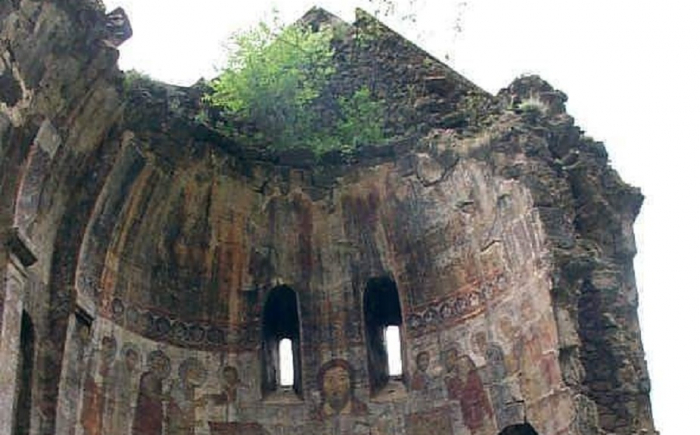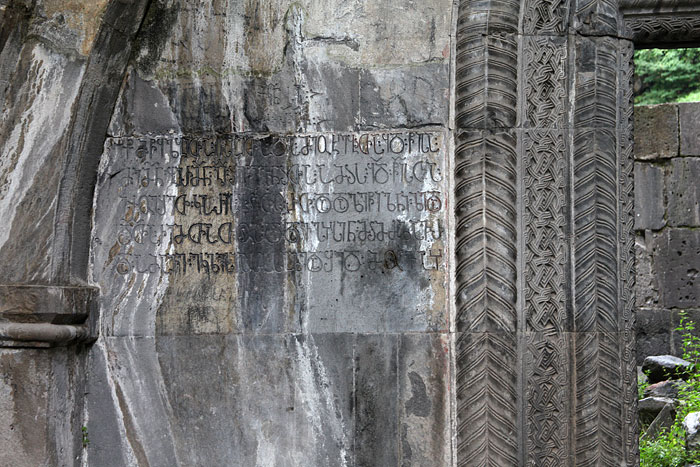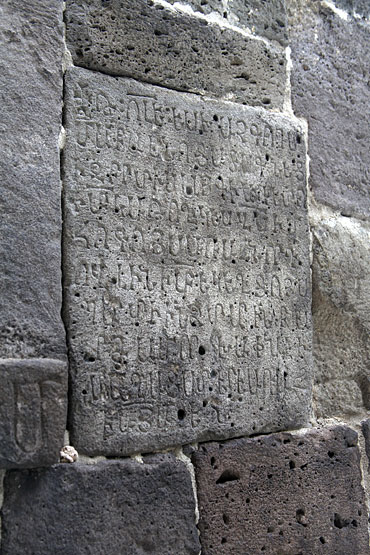ANALYTICS
15.06.21 21:30

With the opening of the land borders between Georgia and the Republic of Armenia, a stream of visitors, guests, tourists, and simply transit passengers rushed to Georgia from Armenia. But in the direction of Armenia, citizens of Georgia who do not have Armenian roots practically do not travel. And as before, the fate of Georgian churches in the territory of the Republic of Armenia is aggravated.
The Armenian state and the Armenian Apostolic Church now formally have no funds for the restoration of the appropriated Georgian churches. However, they have not been particularly restored before. The Armenian authorities and the Armenian Church, formally and illegally owning these churches, deliberately sought to gradually destroy and degrade the monuments of Georgian culture, Georgian shrines.
Because the falsifiers assert that these churches were "Armenian-Khalkedonite" and that khachkars were brought here, the position of the temples did not improve at all. Even intending to attract tourists to Georgian shrines, passed off as Armenian, the authorities continued to treat Georgian temples blasphemously. What the "Caucasus Plus" already wrote in the article "Pashinyan invites tourists to the previously defiled and turned into a stable Georgian monastery Kobairi" (http://en.kavkazplus.com/news.php?id=4723#.YMjbLGgzY2w)
Unfortunately, even now there is no question of giving Georgian and Georgian clergy access to the desecrated and desecrated Georgian shrines. A sad fate at the same Kobairi monastery, which is still abandoned and destroyed.
The Armenians themselves have been writing about the fact that the Kobairi monastery is in a disastrous state for a long time. In particular, the Armenian journalist Mark Grigoryan, back in 2012, published a post in the live magazine Kobair Monastery (https://markgrigorian.livejournal.com/759346.html). Here are some excerpts from it:
Kobair. Fantastic beauty place.
My photographs are not able to convey even a small fraction of this beauty, especially since when I was there, the sky was cloudy, it started to rain and as a result, there was simply no light.
A steep path leads to the monastery, sometimes turning into a staircase made of stones. You cannot drive to Kobair by car - there is no road. On the one hand, this is not bad: there are almost no tourists there. On the other hand, it is not good: it is very difficult to bring equipment to the monastery for restoration work. And they are simply necessary - the dome and the roof of the cathedral collapsed long ago, revealing to all winds and bad weather the unique frescoes of the XII-XIV centuries...
Except for the wooden scaffolding, the frescoes are literally under the open sky - the dome of the cathedral has collapsed, and the unique murals, restored in 1971, are in urgent need of help.
The frescoes are believed to have been created between 1225 and 1250.
The inscription in Georgian on the wall of the cathedral. When the dispute about the ownership of Kobayr is not waged between historians, but at the level of amateurs (such as myself, for example, or one of the commentators on the Georgian TV channel PIK), this inscription is considered to be the rationale for the "Georgianness" of Kobayr. To be fair, I must say that this is not the only inscription in Georgian.

But there are also Armenian inscriptions. Here is one of them.

But all these controversies recede in front of the incredible beauty of the ruins.
When you find yourself there, in the monastery, all these disputes seem so distant and meaningless ... You look at the ruins, you look at the stunning landscapes, and you think: such beauty has no right to disappear. The monastery must be restored..."
It is clear that Mark Grigoryan, as an Armenian and an Armenian nationalist, is trying to accept the point of view of the Armenian appropriators and falsifiers. But even he is worried about the fate of the temple, which 9 years ago was already in a disastrous state, and now it has only worsened. As for its belonging, even a layman's eyes can notice that the slabs with the Georgian inscription look "original" and "natural", and the stone with the Armenian inscription were clearly inserted later. So everything “Armenian” in Kobair is precisely the fruit of the later falsifications.
Kobairi Monastery is a Georgian Orthodox monastery on the territory of modern Armenia. It is located not far from Tumanyan, in the valley of the Debeda River, on the slope of a mountain. It was originally founded in 1171 by Maria, the daughter of the king of Tashir-Dzoraget Kvirike II. Two centuries later, it was significantly destroyed by a strong earthquake. It is known for its unique frescoes created in Georgian and Byzantine traditions.
Here is the grave of Amirspasalar Zakaria Mkhargrdzeli - an outstanding Georgian statesman of the era of Queen Tamar of Kurdish origin and members of his family. In the vicinity of the Kobairi Monastery, there are other crumbling monuments of Georgian architecture that are completely inaccessible to visitors. In the monastery itself, destruction processes are actively underway, the roof has long ago collapsed, atmospheric precipitation destroys the most unique Georgian frescoes, for the preservation of which the Armenian authorities deliberately do not take any action...
The unique Georgian monastery of Akhtala, which is declared by Armenian falsifiers "a monument of Armenian culture", is also being destroyed. Although all the inscriptions in the monastery are Georgian and many of the frescoes depict Georgian shrines. The same applies to the Khnevank monastery in the same Lori mazra and the Khujabi monastery captured by Armenia by moving the border. Not even in question.
The most interesting thing is that the same Armenian authorities allow the destruction and desecration of Georgian shrines, which are hypocritically indignant that, they say, Azerbaijan allegedly "destroys Armenian churches" on its land. Although, in reality, only the restoration of churches is underway and some of them (Russian Orthodox, Albanian) are returning to their original form, which was before they were illegally appropriated by the Armenian Church.
The Georgian Church must declare its right to shrines on the territory of the Republic of Armenia in international instances. Moreover, the Armenian Apostolic Church (AAC) has submitted completely illegal claims to the UN for 442 Georgian churches on the territory of Georgia. The question of admitting Georgian restorers and clergy to the crumbling Georgian churches on Armenia's territory should be raised to try to save them before it is too late. Moreover, Armenia is still dependent on Georgia in terms of transit and other issues, but in the spiritual and cultural sphere, it really behaves in a barbaric manner, allowing the destruction and degradation of Georgian Orthodox churches on its territory and illegally claiming hundreds of Georgian churches on the very territory of Georgia.
It is unacceptable for Georgia and the Georgian Orthodox Church to abandon Georgian relics in the Republic of Armenia, especially those that are pearls of Georgian architecture and outstanding monuments of Georgian culture.
KavkazPlus
Read: 523
Write comment
(In their comments, readers should avoid expressing religious, racial and national discrimination, not use offensive and derogatory expressions, as well as appeals that are contrary to the law)
News feed
-
14:0024.04.24
-
Tbilisi Mayor deems new stadium construction as a mega project
13:2024.04.24
-
12:2424.04.24
-
Rustavi City Council Chairman dismissed
11:3024.04.24
-
10:2224.04.24
-
9:0024.04.24
-
Tusheti Protected Landscape in Georgia’s north-east to expand by 2,245 hectares
18:0023.04.24
-
17:2823.04.24
-
16:5623.04.24
-
16:2023.04.24
-
15:4423.04.24
-
15:0623.04.24
-
Georgian PM, UN representatives review cooperation
14:3523.04.24
-
14:0023.04.24
-
Four people were arrested for making and issuing fake driving licenses
13:2023.04.24
-
12:3923.04.24
-
Georgian, Croatian foreign ministers discuss “fruitful” cooperation
11:3023.04.24
-
Georgian foreign office welcomes border delimitation deal between Armenia, Azerbaijan
10:4523.04.24
-
10:0023.04.24
-
8:0023.04.24
-
18:0022.04.24
-
Prosecutor's Office arrests organized criminal group members involved in call centres
17:2722.04.24
-
Economy Minister: Georgian economy to become “one of fastest-growing” in Europe, wider region
16:5522.04.24
-
Deputy Economy Minister: over million travellers, “record-high” EU visitors entered Georgia in Q1
16:3122.04.24
-
Girchi Party sceptical about their Political Lobbying bill's support in Parliament
16:0022.04.24
-
Russian occupation forces illegally arrest two citizens of Georgia near village of Dirbi
15:3022.04.24
-
14:5722.04.24
-
Shalva Papuashvili: The age permitted for marriage - 18 years - will be written in the Constitution
14:1622.04.24
-
13:1022.04.24
-
Environmental Ministry tightens restrictions on Boxtree cutting
12:3422.04.24
-
12:0522.04.24
-
11:3122.04.24
-
10:0022.04.24
-
18:0019.04.24
-
The state property the government sold this year at the lowest price
17:3019.04.24
-
17:0019.04.24


